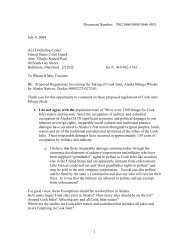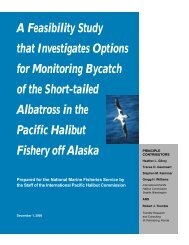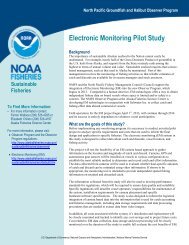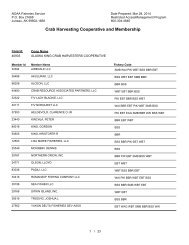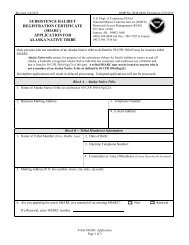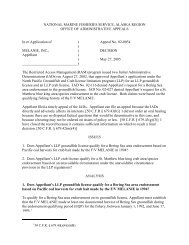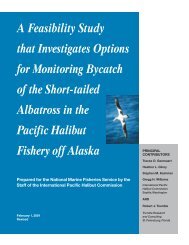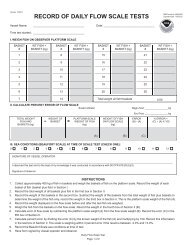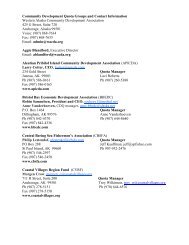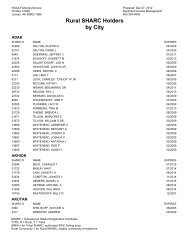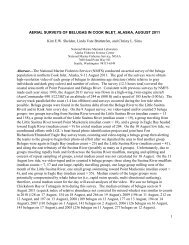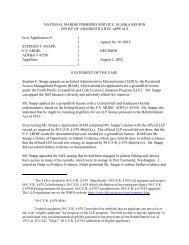Petition to List Lynn Canal Pacific Herring under the Endangered ...
Petition to List Lynn Canal Pacific Herring under the Endangered ...
Petition to List Lynn Canal Pacific Herring under the Endangered ...
You also want an ePaper? Increase the reach of your titles
YUMPU automatically turns print PDFs into web optimized ePapers that Google loves.
Esquimault Harbour / Portage Inlet herring also spawn in late March, later than<br />
herring in most o<strong>the</strong>r locations in <strong>the</strong> Strait of Georgia, and thus both geographic<br />
isolation and differences in timing of spawning may be isolating mechanisms <strong>to</strong><br />
maintain <strong>the</strong> distinctiveness of <strong>the</strong>se populations.<br />
Beacham et al. (2002). Thus, in <strong>Lynn</strong> <strong>Canal</strong> <strong>Herring</strong> ei<strong>the</strong>r one or both of <strong>the</strong>se<br />
mechanisms may be operating <strong>to</strong> make <strong>the</strong> population genetically distinct from o<strong>the</strong>rs.<br />
C. Comparison with Puget Sound <strong>Herring</strong>; Small et al.<br />
(2005).<br />
Small et al. (2005) determined that <strong>the</strong> Squaxin Pass herring population is isolated from<br />
o<strong>the</strong>r herring in <strong>the</strong> Puget Sound, and that this isolation separates this population even<br />
though <strong>the</strong>y spawn at <strong>the</strong> same time as o<strong>the</strong>rs.<br />
The winter spawn timing of Squaxin Pass herring overlaps with o<strong>the</strong>r [Puget<br />
Sound] herring spawn timings, but Squaxin Pass is <strong>the</strong> most physically isolated of<br />
<strong>the</strong> [Puget Sound] populations in <strong>the</strong> study. In addition <strong>to</strong> threading <strong>the</strong>ir way<br />
down <strong>to</strong> <strong>the</strong> sou<strong>the</strong>rn reaches of [Puget Sound], Squaxin Pass herring must<br />
negotiate a glacial sill at <strong>the</strong> Tacoma Narrows approximately 30 km nor<strong>the</strong>ast of<br />
<strong>the</strong> spawning area. <strong>Herring</strong> from north of <strong>the</strong> Tacoma Narrows may be<br />
unmotivated <strong>to</strong> explore in<strong>to</strong> <strong>the</strong> region if aggregation sizes are small (Ware and<br />
Schweigert 2001) and if spawning habitat is available at <strong>the</strong>ir natal sites. The<br />
isolation of Squaxin Pass may be similar <strong>to</strong> Esquimalt Harbor on <strong>the</strong> Sou<strong>the</strong>rn<br />
Coast of Vancouver Island (Beacham et al. 2002) or Bras d’Or Lake along Nova<br />
Scotia (McPherson et al. 2004), where geographic isolation promoted genetic<br />
divergence.<br />
(Small et al. 2005).<br />
In addition, Small et al. (2004) hypo<strong>the</strong>sizes that <strong>Pacific</strong> <strong>Herring</strong> may show<br />
undifferentiated genetics between populations simply by chance.<br />
The most puzzling result from this study is our failure <strong>to</strong> detect differentiation<br />
between herring from <strong>the</strong> Bering Sea and Prince William Sound in Alaska.<br />
Allozyme analysis (Grant and Utter 1984), microsatellites (O’Connell et al. 1998)<br />
and mi<strong>to</strong>chondrial analysis (Bentzen et al. 1998) report significant genetic<br />
differences between herring collected from <strong>the</strong>se locations. By increasing <strong>the</strong><br />
number of microsatellite loci, we expected <strong>to</strong> increase <strong>the</strong> resolution of <strong>the</strong>ir<br />
genetic relationship. The high stray rate reported for BC herring (Ware and<br />
Schweigert 2001) is unlikely between Nor<strong>to</strong>n Sound and Prince William Sound, a<br />
minimum distance of around 3000 kilometers. Ware et al. (2000) found that of<br />
<strong>the</strong> herring that strayed, less than 8% dispersed 800 or more kilometers. This lack<br />
of observed differentiation between spawners from Nor<strong>to</strong>n Sound and Prince<br />
VI



